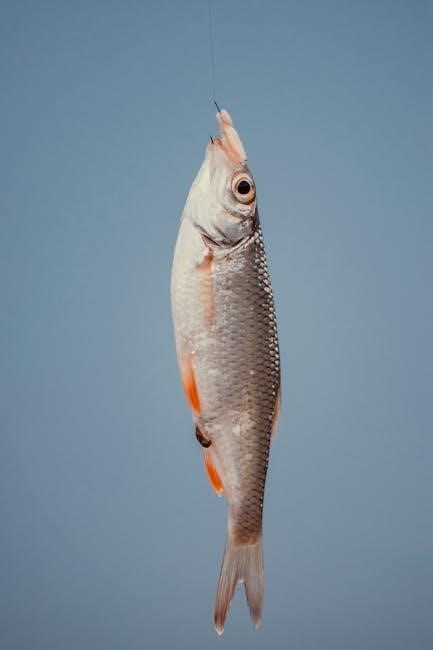rod guide

rod guide
Rod guides are vital components of fishing rods, directing the line for smooth casting and reeling. They come in various types and materials to suit different fishing needs.

Types of Rod Guides
Rod guides come in various types, each designed for specific fishing techniques and needs. Common types include single foot, double foot, roller, micro/nano, and turbo guides.
2.1. Single Foot Guides
Single foot guides are the most common type of rod guide, known for their simplicity and reliability. They feature a single foot that attaches directly to the rod blank, providing excellent line control and sensitivity; These guides are lightweight and ideal for a wide range of fishing applications, including freshwater and saltwater fishing. Single foot guides are particularly popular among fly fishermen and anglers who prioritize precision and responsiveness. Their compact design minimizes weight while maintaining durability, making them a versatile choice for both novice and experienced anglers. They are often paired with small to medium-sized fishing lines and are well-suited for targeting smaller to medium-sized fish species.
2.2. Double Foot Guides

Double foot guides are a popular choice for fishing rods, offering enhanced stability and durability compared to single foot guides. They feature two feet that attach to the rod blank, providing a secure and balanced setup. These guides are ideal for heavy-duty fishing applications, such as saltwater fishing or targeting larger species. Double foot guides are known for their ability to handle heavier lines and greater stress, making them a favorite among experienced anglers. While they may add slightly more weight to the rod, their robust construction and reliability make them a worthwhile investment for serious fishing enthusiasts. They are particularly effective in maintaining consistent line control during intense battles with fish.
2.3. Fishing Rod Roller Guides
Fishing rod roller guides are designed to minimize line friction and wear, especially during high-stress fishing scenarios. These guides feature rollers that spin freely, reducing heat buildup and line damage. They are particularly popular in saltwater fishing and trolling, where large species put significant pressure on the gear. Roller guides are known for their durability and smooth operation, making them ideal for anglers targeting powerful fish. Their design ensures consistent line flow, improving casting distance and accuracy. While they may require more maintenance than other guide types, their performance advantages make them a preferred choice for serious anglers seeking reliability and precision in demanding conditions. Roller guides are a testament to innovative fishing technology.

2.4. Micro Guides and Nano Guides
Micro guides and nano guides represent the latest advancements in rod guide technology, designed for minimal weight and maximum performance. These guides are significantly smaller than traditional models, reducing overall rod weight and enhancing sensitivity. Their compact size allows for more guides to be placed along the rod blank, improving line control and casting accuracy. Micro guides are particularly favored in freshwater and ice fishing, where precision and finesse are crucial. Nano guides take this concept further, offering even smaller diameters for reduced line friction and increased casting distance. Both types are ideal for anglers seeking lightweight, responsive rods without compromising on durability or functionality. Their innovative design makes them a popular choice for modern fishing enthusiasts.
2.5. Turbo Guides
Turbo guides are a specialized type of rod guide designed to enhance line speed and reduce friction during casting. They feature a unique, aerodynamic design that minimizes air resistance, allowing for longer and more precise casts. These guides are particularly popular among surf and saltwater anglers, where distance and accuracy are critical. Turbo guides often incorporate high-performance materials, such as advanced ceramics or titanium, ensuring durability and resistance to wear. Their streamlined shape not only improves casting performance but also reduces line tangles and drag. Overall, turbo guides are a valuable addition to rods used in demanding fishing conditions, offering a blend of power, precision, and reliability for serious anglers.

Materials Used in Rod Guides
Rod guides are made from materials like stainless steel, ceramic, titanium, and carbon fiber. Each material offers unique benefits, such as durability, corrosion resistance, and reduced friction.
3.1. Stainless Steel Guides
Stainless steel guides are highly durable and resistant to corrosion, making them ideal for saltwater fishing. They offer excellent strength and can withstand harsh environmental conditions. Their smooth surface ensures minimal line wear, improving casting distance and accuracy. Stainless steel guides are a popular choice for their reliability and longevity, especially in demanding fishing situations. They are often used on heavy-duty rods targeting large species. Despite their robustness, they remain lightweight, allowing for optimal rod balance and sensitivity. This makes them a versatile option for both freshwater and saltwater applications, catering to a wide range of fishing techniques and preferences.
3.2. Ceramic Guides

Ceramic guides are renowned for their exceptional smoothness and heat resistance, reducing friction and preventing line wear. They are lightweight, enhancing rod sensitivity and balance. Ceramic guides are ideal for freshwater fishing, particularly for species like trout and bass. Their non-abrasive surface protects monofilament and fluorocarbon lines effectively. Although durable, they can be brittle under extreme impact. Ceramic guides are a favorite among fly anglers for their precision and line control. They are often used in high-performance rods, offering a perfect blend of functionality and aesthetics. Their popularity stems from their ability to maintain consistent line flow, ensuring accurate casts and seamless retrieves.
3.3. Titanium Guides
Titanium guides offer a unique combination of strength, corrosion resistance, and lightweight design. They are highly durable, making them ideal for saltwater fishing where exposure to harsh marine environments is common. Titanium guides are resistant to rust and abrasion, ensuring longevity even in challenging conditions. Their flexibility prevents breakage under stress, while their smooth surface minimizes line friction. These guides are often used in high-end rods for their exceptional performance and reliability. Titanium’s natural corrosion resistance eliminates the need for additional coatings, making them a popular choice for anglers seeking durability and reliability without added weight. They are particularly favored for their balance of strength and sensitivity, enhancing the overall fishing experience.
3.4. Carbon Fiber Guides
Carbon fiber guides are renowned for their exceptional lightweight and high strength-to-weight ratio. This material is highly corrosion-resistant, making it suitable for both freshwater and saltwater fishing. Carbon fiber guides are known for their smooth, friction-reducing surfaces, which protect the fishing line from abrasion and wear. They also offer excellent heat dissipation, preventing line damage from friction-generated heat. These guides are ideal for anglers seeking a balance of sensitivity and durability. Their lightweight design allows for longer casting distances and reduced fatigue during extended fishing sessions. Carbon fiber guides are often used in high-performance rods, catering to anglers who prioritize precision and responsiveness. Their modern design and advanced material properties make them a preferred choice for many fishing enthusiasts.

Performance Factors of Rod Guides

Rod guide performance depends on design, material, and placement, impacting line efficiency, casting distance, and overall fishing experience. Proper guide selection ensures optimal durability and sensitivity.
4.1. Line Size and Guide Compatibility
Proper line size and guide compatibility are crucial for optimal fishing performance. Guides must accommodate the line’s diameter to prevent friction and abrasion, ensuring smooth casting and retrieval. Compatibility ensures minimal wear on both the line and the guides, enhancing durability. Mismatched guides can lead to poor line control, reduced casting distance, and increased risk of line breakage. Selecting guides that match the line size ensures efficient energy transfer and maintains the rod’s sensitivity. This balance is essential for achieving consistent and effective fishing results across various techniques and environments.
4.2. Guide Spacing and Placement
Proper guide spacing and placement are critical for optimal rod performance. Guides should be strategically positioned to reduce line wear, prevent tangles, and enhance casting distance. The spacing between guides varies based on rod length, action, and intended use, ensuring smooth line flow. Incorrect placement can lead to poor line control, reduced sensitivity, and decreased accuracy. Many anglers use charts or guides to determine optimal spacing, especially for custom rod builds. Properly spaced guides improve casting efficiency and overall fishing performance, making them a key factor in rod design and functionality. Attention to detail in guide placement ensures a more enjoyable and successful fishing experience.
4.3. Action and Power of the Rod
The action and power of a rod significantly influence guide selection and performance. Action refers to the rod’s bending ability, with options like fast, medium, or slow action. Fast action rods bend near the tip, requiring guides that minimize line friction. Slow action rods bend more throughout, needing guides that allow for consistent line flow; Power relates to the rod’s strength, impacting the size and material of guides. Matching guides to the rod’s action and power ensures optimal performance, enabling better casting, sensitivity, and control. Proper alignment between guides and rod characteristics is essential for achieving the desired fishing experience and effectiveness in various fishing conditions and techniques.

Applications of Rod Guides
Rod guides are essential for various fishing environments, including freshwater, saltwater, fly fishing, and ice fishing, enhancing performance and versatility across different techniques and conditions.
5.1. Freshwater Fishing
Freshwater fishing relies heavily on rod guides to enhance casting accuracy and line control. Single foot, double foot, and micro guides are popular choices for freshwater scenarios, offering durability and precision. These guides minimize line friction, allowing for smoother casts and retrieves in rivers, lakes, and ponds. For species like bass, trout, and walleye, the right guide setup ensures optimal performance. Freshwater fishing often involves lighter lines and smaller lures, making guide size and spacing critical for balanced rod action. Ceramic and stainless steel guides are favored for their corrosion resistance and smooth line flow, ensuring reliability in freshwater environments. Properly configured guides improve sensitivity, helping anglers detect even subtle bites.
5.2. Saltwater Fishing
Saltwater fishing demands robust rod guides due to the harsh marine environment and larger, more powerful fish. Stainless steel and titanium guides are commonly used for their strength and corrosion resistance. These materials withstand the abrasive effects of saltwater and heavy lines. Roller guides are particularly popular for saltwater fishing, reducing line wear during intense battles with species like marlin and tuna. Proper guide spacing and size are crucial to handle the stress of long casts and heavy loads. Additionally, ceramic inserts in guides help minimize friction, ensuring smooth line flow even under extreme conditions. The durability and performance of saltwater rod guides are essential for successful offshore and coastal fishing adventures. Anglers rely on these components to land trophy catches effectively.
5.3. Fly Fishing
Fly fishing relies heavily on precision and line control, making rod guides a critical component. Fly rods often use single-foot or double-foot wire guides, designed to handle lightweight lines and delicate presentations. These guides are typically smaller in diameter to minimize line friction and ensure smooth casting. Stainless steel or titanium guides are popular for their strength and corrosion resistance, while ceramic inserts further reduce friction. Proper guide placement and sizing are essential for maintaining the rod’s action and sensitivity. Fly fishing guides must balance durability with lightweight construction to accommodate the unique demands of casting and retrieving flies. Their design ensures optimal performance for both freshwater and saltwater fly fishing scenarios.
5.4. Ice Fishing
Ice fishing requires durable and reliable rod guides to withstand harsh, cold conditions. Guides for ice fishing rods are designed to handle thick lines and withstand icy environments. Stainless steel or ceramic guides are commonly used for their strength and corrosion resistance. The large diameter of these guides allows for smooth line flow, even with heavy lines and in freezing temperatures. Brightly colored guides enhance visibility on the ice, helping anglers detect bites more easily. Ice fishing guides are also designed to minimize ice buildup, ensuring consistent performance. Their robust construction supports the fight against larger fish like pike and walleye, making them essential for successful ice fishing adventures.

Modern Innovations in Rod Guides
Modern innovations include TenFlow™ rod guides, reducing turbulence and enhancing durability. Custom rod wraps and advanced materials improve performance, offering anglers precision and reliability in various fishing conditions.
6.1. TenFlow Rod Guide Technology
TenFlow™ rod guide technology represents a significant advancement in fishing gear innovation. Designed to minimize turbulence, these guides enhance line flow and reduce friction, allowing for smoother casting and retrieval. By incorporating high erodible wear volume, TenFlow guides offer exceptional durability, even in harsh fishing conditions. This technology is particularly beneficial for anglers seeking improved accuracy and control, as it ensures consistent line performance across various fishing styles. Its innovative design also contributes to reduced line wear, extending the lifespan of both the guide and the fishing line. TenFlow guides are a testament to modern engineering, blending performance, reliability, and versatility for anglers worldwide.
6.2. Custom Rod Wraps and Guide Systems
Custom rod wraps and guide systems allow anglers to personalize their fishing gear for enhanced performance and style. These tailored setups enable precise customization of guide placement, size, and material to match specific fishing techniques and preferences. By optimizing guide spacing and alignment, custom systems improve line flow and reduce friction, leading to smoother casting and retrieval. Additionally, anglers can choose aesthetics such as thread colors and patterns to create unique rod designs. This level of personalization not only elevates the fishing experience but also ensures the rod is perfectly suited to the angler’s needs, whether for freshwater, saltwater, or specialized fishing methods like fly fishing or ice fishing.